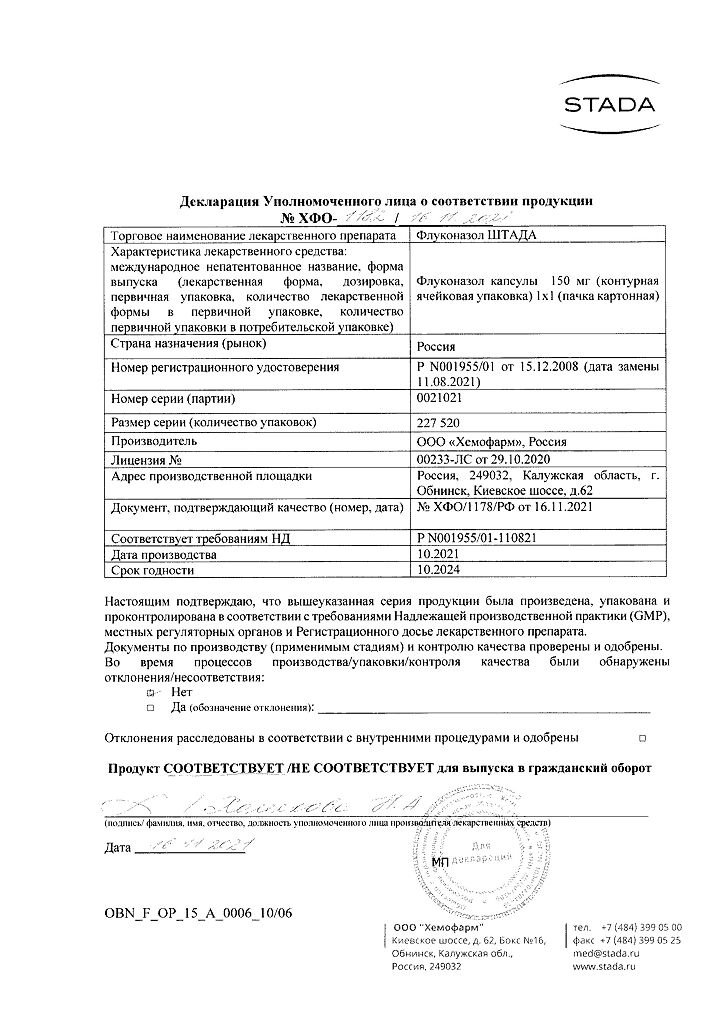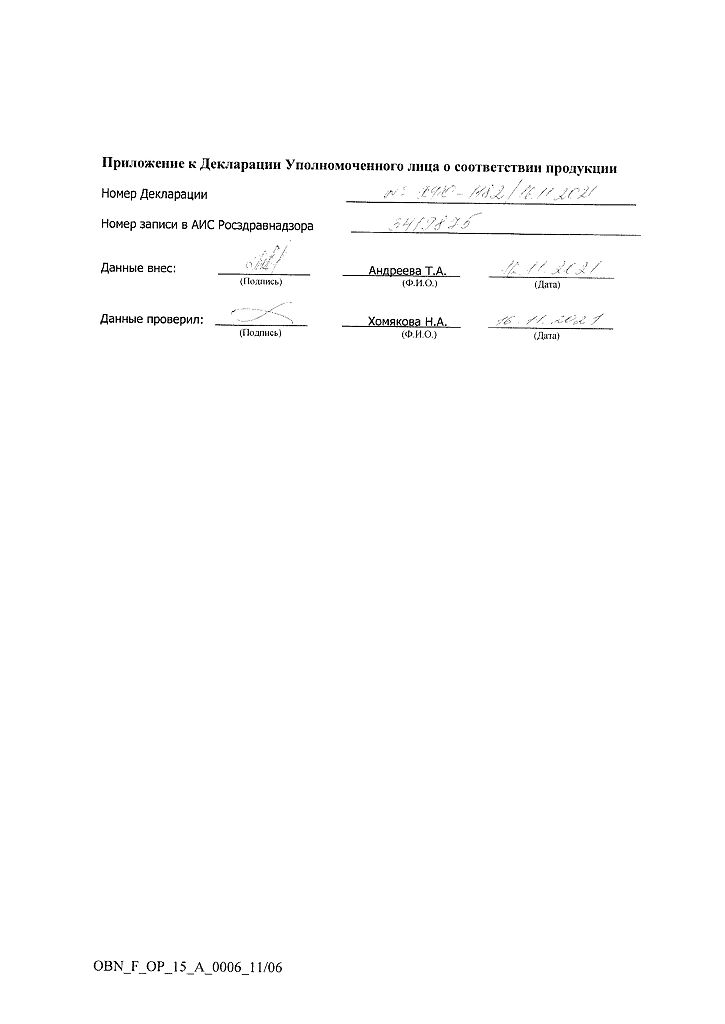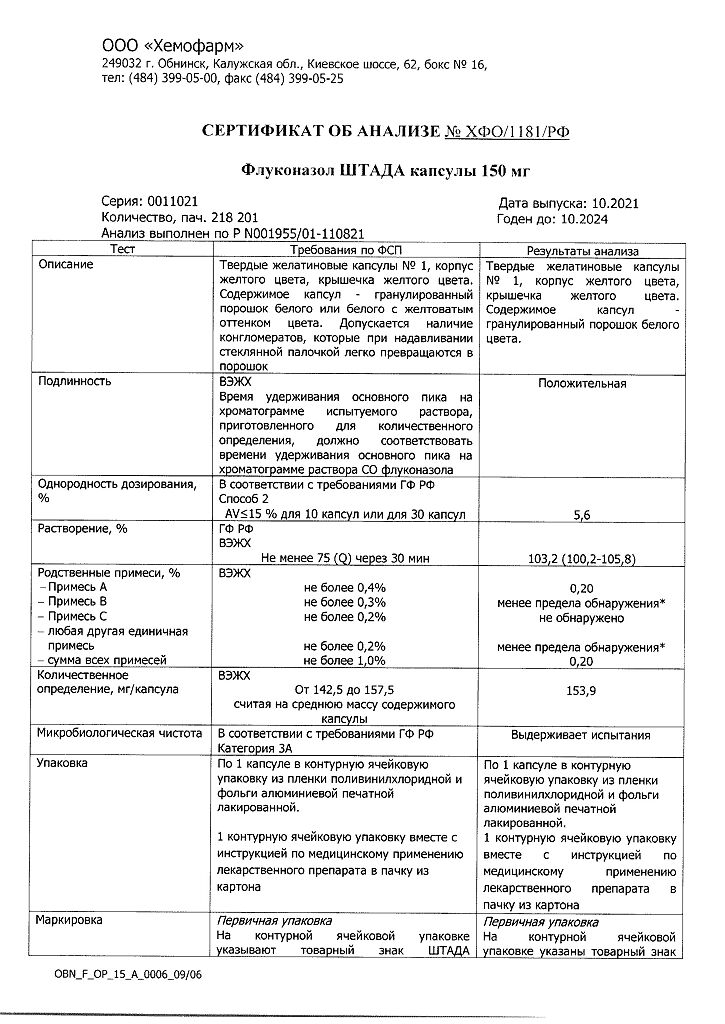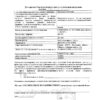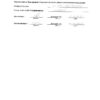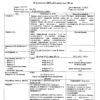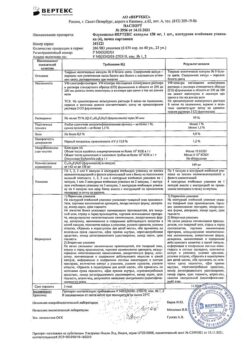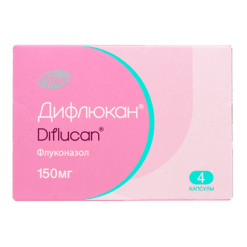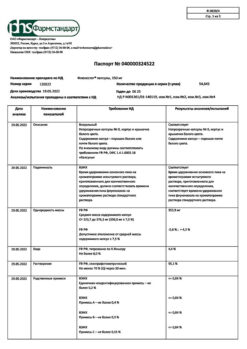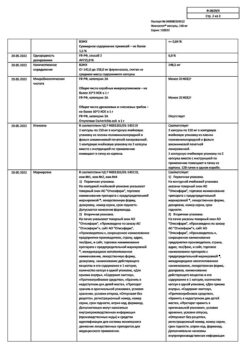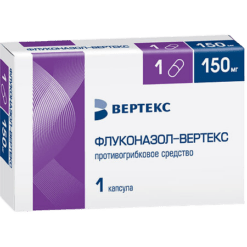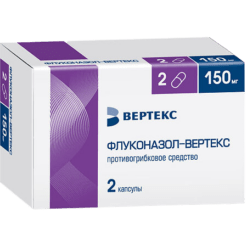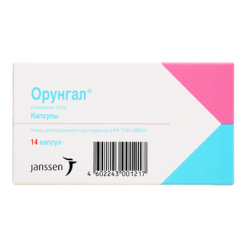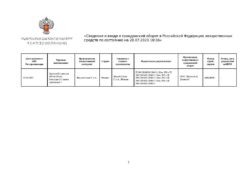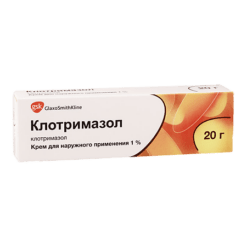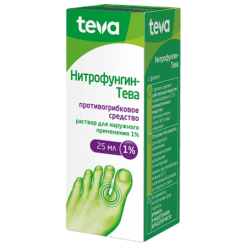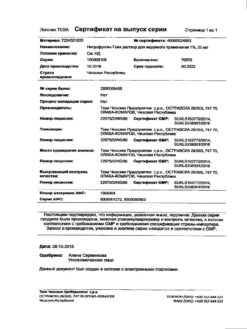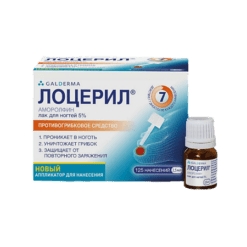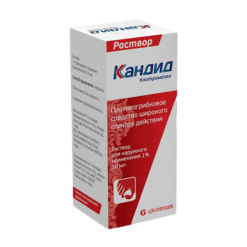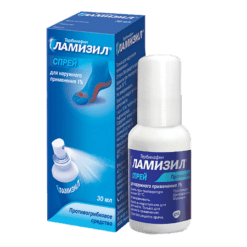No products in the cart.
Fluconazole Stada, 150 mg capsules
€2.72 €2.47
Description
Antifungal agent, has a highly specific action by inhibiting the activity of cytochrome P450-dependent enzymes of fungi.
Blocks conversion of lanosterol of fungal cells into membrane lipid – ergosterol; increases cell membrane permeability, disrupts its growth and replication.
Fluconazole, being highly selective for cytochrome P450 of fungi, practically does not inhibit these enzymes in humans (in comparison with itraconazole, clotrimazole, econazole and ketoconazole it inhibits cytochrome P450 dependent oxidation processes in human liver microsomes to a lesser extent).
It has no antihydrogenic activity.
It is active in opportunistic mycoses, including those caused by Candida spp. (including generalized candidiasis against immunosuppression), Cryptococcus neoformans and Cossidioides immitis (including intracranial infections), Microsporum spp. and Trichophyton spp.;
in endemic mycoses caused by Blastomyces dermatidis, Histoplasma capsulatum (including immunosuppression).
Pharmacokinetics
Fluconazole is well absorbed after oral administration, the absorption rate of fluconazole is not affected by food intake, its bioavailability is 90%.
The time of maximum concentration after oral administration on an empty stomach of 150 mg of the preparation is 0,5-1,5 h, Cmax is 90% of concentration in plasma in case of per oral administration with a dose of 2,5-3,5 mg/l. T1/2 fluconazole is 30 h.
The binding to plasma proteins is 11-12%. Plasma concentration is in direct dependence on the dose. 90% level of equilibrium concentration is reached by 4-5 days of therapy (when taken once daily).
The administration of a shock dose (on the first day), 2 times the usual daily dose, allows reaching the level of concentration corresponding to 90% of the equilibrium concentration by the second day.
Fluconazole penetrates well into all body fluids. Concentrations of the active substance in breast milk, joint fluid, saliva, sputum and peritoneal fluid are similar to its levels in plasma.
The steady values in vaginal secretion are reached 8 hours after oral administration and are maintained at these levels for at least 24 hours.
Fluconazole penetrates cerebrospinal fluid (CSF) well – in fungal meningitis the concentration in CSF is about 85% of its level in plasma.
In sweat fluid, epidermis and stratum corneum (selective accumulation), concentrations higher than serum concentrations are achieved.
After oral administration of 150 mg on day 7, the concentration in the stratum corneum of the skin is 23.4 mcg/g and, 1 week after the second dose, 7.1 mcg/g; the concentration in the nails after 4 months of use at a dose of 150 mg once a week is 4.05 mcg/g in healthy and 1.8 mcg/g in the affected nails.
The volume of distribution approximates the total water content of the body.
It is an inhibitor of CYP2C9 isoenzyme in the liver. It is excreted mainly by the kidneys (80% – unchanged, 11% – as metabolites).
The clearance of fluconazole is proportional to creatinine clearance. No fluconazole metabolites were detected in peripheral blood.
The pharmacokinetics of fluconazole significantly depends on the functional state of the kidneys, and there is an inverse relationship between the elimination half-life and creatinine clearance.
After hemodialysis within 3 hours plasma concentration of fluconazole decreases by 50%.
Indications
Indications
cryptococcosis, including cryptococcal meningitis and other localizations of this infection (including lungs, skin), both in patients with a normal immune response and in patients with various forms of immunosuppression (including AIDS patients, organ transplants); the drug can be used to prevent cryptococcal infection in patients with AIDS;
candidiasis of the mucous membranes, incl. oral cavity and pharynx (including atrophic candidiasis of the oral cavity associated with wearing dentures), esophagus, non-invasive bronchopulmonary candidiasis, candiduria; prevention of relapse of oropharyngeal candidiasis in patients with AIDS;
genital candidiasis: vaginal candidiasis (acute and chronic recurrent); prophylactic use to reduce the frequency of relapses of vaginal candidiasis (3 or more episodes per year); candidal balanitis;
generalized candidiasis, including candidemia, disseminated candidiasis and other forms of invasive candidal infections (infections of the peritoneum, endocardium, eyes, respiratory and urinary tract). Treatment can be carried out in patients with malignant neoplasms, patients in intensive care units, patients undergoing cytostatic or immunosuppressive therapy, as well as in the presence of other factors predisposing to the development of candidiasis;
mycoses of the skin, including mycoses of the feet, body, and groin area; pityriasis versicolor (varicolored) lichen, onychomycosis and skin candidiasis infections;
deep endemic mycoses, including coccidioidomycosis, paracoccidioidomycosis, sporotrichosis and histoplasmosis in patients with normal immunity;
prevention of fungal infections in patients with malignant neoplasms who are predisposed to such infections as a result of chemotherapy with cytostatics or radiation therapy.
Pharmacological effect
Pharmacological effect
An antifungal agent that has a highly specific effect, inhibiting the activity of fungal enzymes dependent on cytochrome P450.
Blocks the conversion of lanosterol from fungal cells into the membrane lipid – ergosterol; increases the permeability of the cell membrane, disrupts its growth and replication.
Fluconazole, being highly selective for fungal cytochrome P450, practically does not inhibit these enzymes in the human body (in comparison with itraconazole, clotrimazole, econazole and ketoconazole, it suppresses cytochrome P450-dependent oxidative processes in human liver microsomes to a lesser extent).
Does not have antiadrogenic activity.
Active against opportunistic mycoses, incl. caused by Candida spp. (including generalized forms of candidiasis due to immunosuppression), Cryptococcus neoformans and Coccidioides immitis (including intracranial infections), Microsporum spp. and Trichophyton spp.;
for endemic mycoses caused by Blastomyces dermatidis, Histoplasma capsulatum (including immunosuppression).
Pharmacokinetics
After oral administration, fluconazole is well absorbed; food intake does not affect the rate of absorption of fluconazole, its bioavailability is 90%.
The time to reach maximum concentration after oral administration of 150 mg of the drug on an empty stomach is 0.5–1.5 hours, Cmax is 90% of the plasma concentration when administered intravenously at a dose of 2.5–3.5 mg/l. T1/2 of fluconazole is 30 hours.
Bonding with plasma proteins is 11–12%. Plasma concentration is directly dependent on dose. A 90% level of equilibrium concentration is achieved by the 4th–5th day of treatment with the drug (when taken once a day).
Administration of a loading dose (on the first day), 2 times higher than the usual daily dose, allows one to achieve a concentration level corresponding to 90% of the equilibrium concentration by the second day.
Fluconazole penetrates well into all biological fluids of the body. Concentrations of the active substance in breast milk, joint fluid, saliva, sputum and peritoneal fluid are similar to its levels in plasma.
Constant values in vaginal secretions are achieved 8 hours after oral administration and are maintained at this level for at least 24 hours.
Fluconazole penetrates well into the cerebrospinal fluid (CSF) – with fungal meningitis, the concentration in the CSF is about 85% of its plasma level.
In sweat fluid, epidermis and stratum corneum (selective accumulation) concentrations exceeding serum levels are achieved.
After oral administration of 150 mg on the 7th day, the concentration in the stratum corneum of the skin is 23.4 mcg/g, and 1 week after taking the second dose – 7.1 mcg/g; concentration in nails after 4 months of use at a dose of 150 mg once a week is 4.05 mcg/g in healthy and 1.8 mcg/g in affected nails.
The volume of distribution approaches the total water content of the body.
It is an inhibitor of the CYP2C9 isoenzyme in the liver. It is excreted primarily by the kidneys (80% unchanged, 11% in the form of metabolites).
Fluconazole clearance is proportional to creatinine clearance. No fluconazole metabolites were detected in peripheral blood.
The pharmacokinetics of fluconazole depends significantly on the functional state of the kidneys, and there is an inverse relationship between the half-life and creatinine clearance.
After hemodialysis for 3 hours, the concentration of fluconazole in plasma decreases by 50%.
Special instructions
Special instructions
Treatment must be continued until clinical and hematological remission occurs. Premature cessation of treatment leads to relapses.
In rare cases, the use of fluconazole was accompanied by toxic changes in the liver, incl. with a fatal outcome, mainly in patients with serious concomitant diseases.
In the case of hepatotoxic effects associated with fluconazole, there was no obvious dependence on the total daily dose, duration of therapy, gender, and age of the patient.
The hepatotoxic effects of fluconazole were usually reversible; its signs disappeared after cessation of therapy.
If clinical signs of liver damage that may be associated with fluconazole appear, the drug should be discontinued.
People with AIDS are more likely to develop severe skin reactions when taking many drugs.
In cases where a rash develops in patients with a superficial fungal infection, and it is assessed as definitely related to fluconazole, the drug should be discontinued.
If a rash appears in patients with invasive/systemic fungal infections, they should be carefully monitored and fluconazole should be discontinued if bullous changes or erythema multiforme occur.
Caution must be exercised when taking fluconazole concomitantly with rifabutin or other drugs metabolized by the cytochrome P450 system.
When using fluconazole and oral hypoglycemic agents (chlorpropamide, glibenclamide, glipizide, tolbutamide) together in patients with diabetes mellitus, blood glucose levels should be monitored (the possibility of developing hypoglycemia).
It is recommended to monitor the concentration of cyclosporine in the blood when used simultaneously with fluconazole.
Patients who are receiving high doses of theophylline concomitantly with fluconazole, or who are at risk of developing theophylline toxicity, should be monitored for early detection of symptoms of theophylline overdose.
Impact on the ability to drive a car and operate machinery
Impairment of the ability to drive a car and operate machinery associated with the use of the drug is unlikely.
Active ingredient
Active ingredient
Fluconazole
Composition
Composition
1 capsule contains:
Active ingredient:
Fluconazole 150 mg;
Excipients:
Lactose,
Potato starch,
Croscarmellose sodium (primellose),
Povidone (low molecular weight medical polyvinylpyrrolidone),
Magnesium stearate,
Talc;
Capsules No. 1:
Gelatin,
Titanium dioxide,
Quinoline yellow dye [E104],
Sunset yellow dye [E110]
Pregnancy
Pregnancy
The use of the drug in pregnant women is not advisable, with the exception of severe or life-threatening forms of fungal infections, when the potential benefit of fluconazole for the mother significantly outweighs the risk to the fetus.
Since the concentration of fluconazole in breast milk and plasma is the same, the use of the drug during lactation is contraindicated.
Contraindications
Contraindications
hypersensitivity to fluconazole, other components of the drug or azole compounds with a structure similar to fluconazole;
simultaneous use of terfenadine (against the background of constant use of fluconazole at a dose of 400 mg/day or more);
simultaneous use of cisapride, astemizole, as well as other drugs that prolong the QT interval;
lactation period;
children under 4 years of age.
With caution: liver and/or renal failure, rash during the use of fluconazole in patients with superficial fungal infection and invasive/systemic fungal infections,
simultaneous use of terfenadine and fluconazole at a dose of less than 400 mg/day, simultaneous use of potentially hepatotoxic drugs, alcoholism, potentially proarrhythmogenic conditions in patients with
multiple risk factors (organic heart disease, electrolyte imbalance, simultaneous use of medications that cause arrhythmias), pregnancy.
Side Effects
Side Effects
From the digestive system:
decreased appetite, changes in taste, nausea, vomiting, abdominal pain, flatulence, diarrhea, rarely – impaired liver function (hyperbilirubinemia, increased activity of alanine aminotransferase, aspartate aminotransferase, increased activity of alkaline phosphatase, jaundice, hepatitis, hepatocellular necrosis).
From the nervous system:
headache, dizziness, excessive fatigue, rarely – convulsions.
From the hematopoietic organs:
rarely – leukopenia, thrombocytopenia (bleeding, petechiae), neutropenia, agranulocytosis.
From the cardiovascular system:
increase in the duration of the Q-T interval, ventricular fibrillation/flutter.
Allergic reactions:
skin rash, rarely – exudative erythema multiforme (including Stevens-Johnson syndrome), toxic epidermal necrolysis (Lyell’s syndrome), anaphylactoid reactions (including angioedema, facial edema, urticaria, skin itching).
Others:
rarely – renal dysfunction, alopecia, hypercholesterolemia, hypertriglyceridemia, hypokalemia.
Interaction
Interaction
When fluconazole is used with warfarin, the prothrombin time increases (by an average of 12%).
In this regard, it is recommended to carefully monitor prothrombin time in patients receiving the drug in combination with coumarin anticoagulants.
It is possible to increase the half-life of oral hypoglycemic agents – sulfonylurea derivatives (chlorpropamide, glibenclamide, glipizide, tolbutamide) when taken simultaneously with fluconazole.
Concomitant use of fluconazole and phenytoin may lead to an increase in plasma phenytoin concentrations to a clinically significant extent.
Therefore, if it is necessary to use these drugs together, it is necessary to monitor phenytoin concentrations with dose adjustment in order to maintain drug levels within the therapeutic interval.
The combination with rifampshchin leads to a decrease in AUC by 25% and a shortening of the plasma half-life of fluconazole by 20%. Therefore, in patients receiving rifampicin at the same time, it is advisable to increase the dose of fluconazole.
It is possible to increase the concentration of cyclosporine when used simultaneously with fluconazole at a dose of 200 mg/day.
In case of simultaneous administration with theophylline, a decrease in the average rate of clearance of theophylline from plasma is possible.
With simultaneous use of fluconazole and cisapride, the plasma concentration of cisapride may increase significantly; Cases of adverse reactions from the heart have been described, incl. ventricular fibrillation/flutter including (torsades de points), increased QT interval on ECG.
Concomitant use of azole antifungals and terfenadine may lead to a significant increase in plasma terfenadine levels: serious arrhythmias may occur as a result of an increase in the QT interval.
Concomitant use of fluconazole and hydrochlorothiazide can lead to an increase in plasma concentrations of fluconazole by 40%.
There are reports of interaction between fluconazole and rifabutin, accompanied by an increase in serum levels of the latter.
Cases of uveitis have been described with the simultaneous use of fluconazole and rifabutin. Patients receiving rifabutan and fluconazole simultaneously should be carefully monitored.
In patients receiving a combination of fluconazole and zidovudine, an increase in the concentration of zidovudine is observed, which is caused by a decrease in the conversion of the latter to its main metabolite, so an increase in the side effects of zidovudine should be expected.
Increases the concentration of midazolam, and therefore increases the risk of developing psychomotor effects (more pronounced when fluconazole is used orally than intravenously).
Increases the concentration of tacrolimus, which increases the risk of nephrotoxicity.
Overdose
Overdose
Symptoms: hallucinations, paranoid behavior.
Treatment is symptomatic: gastric lavage, forced diuresis.
Hemodialysis within 3 hours reduces plasma concentrations by approximately 50%.
Storage conditions
Storage conditions
In a dry place, protected from light, at a temperature not exceeding 25°C.
Shelf life
Shelf life
3 years.
Manufacturer
Manufacturer
Hemofarm LLC, Russia
Additional information
| Shelf life | 3 years. |
|---|---|
| Conditions of storage | In a dry, light-protected place at a temperature not exceeding 25 ° C. |
| Manufacturer | Chemopharm LLC, Russia |
| Medication form | capsules |
| Brand | Chemopharm LLC |
Other forms…
Related products
Buy Fluconazole Stada, 150 mg capsules with delivery to USA, UK, Europe and over 120 other countries.


